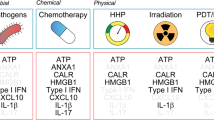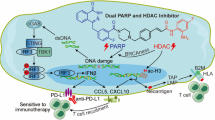Abstract
Protein synthesis is crucial for regulating cell homeostasis and, when unrestricted, it can lead to tumorigenesis. Immunotoxins derived from Pseudomonas exotoxin are antibody–toxin fusion proteins that inhibit protein synthesis of mammalian cells via ADP-ribosylation of the eukaryotic elongation factor-2. Here we investigate the role of the Bcl-2 family proteins in the response of cancer cells to immunotoxin challenge. Besides the well-known reduction of the prosurvival Bcl-2 family member, Mcl-1, following inhibition of protein synthesis, we show for the first time that immunotoxins also reduce the levels of selected proapoptotic BH-3-only proteins. Among these, only Bim protein levels correlated with the ability of immunotoxins to induce an apoptotic response. To support our findings, we verified that a Bim knockout completely abolished immunotoxin-mediated apoptosis. Further, mice bearing either wild-type or Bid knockout tumors responded to immunotoxin treatment with a decrease in growth kinetics, whereas mice engrafted with Bim knockout tumors showed no reduction in tumor size or prolongation of survival following immunotoxin treatment. From these results, we conclude that Bim expression is a major susceptibility factor for tumor cell death and, as such, constitutes a potential biomarker that could be evaluated before immunotoxin treatment. In support of this hypothesis, clinically, we analyzed patient cells before immunotoxin treatment and report that samples of hairy cell leukemia with high levels of Bim protein responded with a greater decrease in leukemic cell count compared with those samples expressing a low level of Bim.
This is a preview of subscription content, access via your institution
Access options
Subscribe to this journal
Receive 50 print issues and online access
$259.00 per year
only $5.18 per issue
Buy this article
- Purchase on Springer Link
- Instant access to full article PDF
Prices may be subject to local taxes which are calculated during checkout







Similar content being viewed by others
References
Adams JM, Cory S . Bcl-2-regulated apoptosis: mechanism and therapeutic potential. Curr Opin Immunol 2007; 19: 488–496.
Chipuk JE, Moldoveanu T, Llambi F, Parsons MJ, Green DR . The BCL-2 family reunion. Mol Cell 2010; 37: 299–310.
Hata AN, Engelman JA, Faber AC . The BCL2 family: key mediators of the apoptotic response to targeted anticancer therapeutics. Cancer Discov 2015; 5: 475–487.
Weldon JE, Pastan I . A guide to taming a toxin—recombinant immunotoxins constructed from Pseudomonas exotoxin A for the treatment of cancer. FEBS J 2011; 278: 4683–4700.
Antignani A, Fitzgerald D . Immunotoxins: the role of the toxin. Toxins (Basel) 2013; 5: 1486–1502.
FitzGerald DJ, Wayne AS, Kreitman RJ, Pastan I . Treatment of hematologic malignancies with immunotoxins and antibody-drug conjugates. Cancer Res 2011; 71: 6300–6309.
Wayne AS, Fitzgerald DJ, Kreitman RJ, Pastan I . Immunotoxins for leukemia. Blood 2014; 123: 2470–2477.
Alewine C, Hassan R, Pastan I . Advances in anticancer immunotoxin therapy. Oncologist 2015; 20: 176–185.
Antignani A, Sarnovsky R, FitzGerald DJ . ABT-737 promotes the dislocation of ER luminal proteins to the cytosol, including Pseudomonas exotoxin. Mol Cancer Ther 2014; 13: 1655–1663.
Andersson Y, Juell S, Fodstad O . Downregulation of the antiapoptotic MCL-1 protein and apoptosis in MA-11 breast cancer cells induced by an anti-epidermal growth factor receptor-Pseudomonas exotoxin a immunotoxin. Int J Cancer 2004; 112: 475–483.
Traini R, Ben-Josef G, Pastrana DV, Moskatel E, Sharma AK, Antignani A et al. ABT-737 overcomes resistance to immunotoxin-mediated apoptosis and enhances the delivery of Pseudomonas exotoxin-based proteins to the cell cytosol. Mol Cancer Ther 2010; 9: 2007–2015.
Hollevoet K, Antignani A, Fitzgerald DJ, Pastan I . Combining the antimesothelin immunotoxin SS1P with the BH3-mimetic ABT-737 induces cell death in SS1P-resistant pancreatic cancer cells. J Immunother 2014; 37: 8–15.
Lindqvist LM, Vikstrom I, Chambers JM, McArthur K, Ann Anderson M, Henley KJ et al. Translation inhibitors induce cell death by multiple mechanisms and Mcl-1 reduction is only a minor contributor. Cell Death Dis 2012; 3: e409.
Willis SN, Fletcher JI, Kaufmann T, van Delft MF, Chen L, Czabotar PE et al. Apoptosis initiated when BH3 ligands engage multiple Bcl-2 homologs, not Bax or Bak. Science 2007; 315: 856–859.
Ren D, Tu HC, Kim H, Wang GX, Bean GR, Takeuchi O et al. BID, BIM, and PUMA are essential for activation of the BAX- and BAK-dependent cell death program. Science 2010; 330: 1390–1393.
Kreitman RJ, Tallman MS, Robak T, Coutre S, Wilson WH, Stetler-Stevenson M et al. Phase I trial of anti-CD22 recombinant immunotoxin moxetumomab pasudotox (CAT-8015 or HA22) in patients with hairy cell leukemia. J Clin Oncol 2012; 30: 1822–1828.
Kreitman RJ, Pastan I . Immunoconjugates in the management of hairy cell leukemia. Best Pract Res Clin Haematol 2015; 28: 236–245.
Salvatore G, Nagata S, Billaud M, Santoro M, Vecchio G, Pastan I . Generation and characterization of novel monoclonal antibodies to the Ret receptor tyrosine kinase. Biochem Biophys Res Commun 2002; 294: 813–817.
Antignani A, Mathews Griner L, Guha R, Simon N, Pasetto M, Keller J et al. Chemical screens identify drugs that enhance or mitigate cellular responses to antibody-toxin fusion proteins. PLoS ONE 2016; 11: e0161415.
Chen L, Willis SN, Wei A, Smith BJ, Fletcher JI, Hinds MG et al. Differential targeting of prosurvival Bcl-2 proteins by their BH3-only ligands allows complementary apoptotic function. Mol Cell 2005; 17: 393–403.
Buchner J, Pastan I, Brinkmann U . A method for increasing the yield of properly folded recombinant fusion proteins: single-chain immunotoxins from renaturation of bacterial inclusion bodies. Anal Biochem 1992; 205: 263–270.
Aubrey BJ, Kelly GL, Kueh AJ, Brennan MS, O'Connor L, Milla L et al. An inducible lentiviral guide RNA platform enables the identification of tumor-essential genes and tumor-promoting mutations in vivo. Cell Rep 2015; 10: 1422–1432.
Dull T, Zufferey R, Kelly M, Mandel RJ, Nguyen M, Trono D et al. A third-generation lentivirus vector with a conditional packaging system. J Virol 1998; 72: 8463–8471.
Stewart SA, Dykxhoorn DM, Palliser D, Mizuno H, Yu EY, An DS et al. Lentivirus-delivered stable gene silencing by RNAi in primary cells. RNA 2003; 9: 493–501.
Acknowledgements
The authors thank R Anderson and W Welch for the gift of reagents and Jianan Gong and Stephen Wilcox for assistance with sequence validation of CRISPR/Cas9 knockout cell lines. We thank E Arons for advice on the RT–PCR. This work was funded by the intramural programs of the National Cancer Institute, NIH and is supported by fellowships, and grants from the Australian National Health and Medical Research Council (research fellowships to DCSH; project grant 1057742 (DCSH); program grant 1016701; and Independent Research Institutes Infrastructure Support Scheme (grant 9000220)), the Cancer Council Victoria (grant-in-aid to DCSH), the Leukemia and Lymphoma Society (Specialized Centers of Research grants 7001-13), the Australian Cancer Research Foundation, a Victorian State Government Operational Infrastructure Support grant.
Author information
Authors and Affiliations
Corresponding authors
Ethics declarations
Competing interests
The authors declare no conflict of interest.
Additional information
Supplementary Information accompanies this paper on the Oncogene website
Supplementary information
Rights and permissions
About this article
Cite this article
Antignani, A., Segal, D., Simon, N. et al. Essential role for Bim in mediating the apoptotic and antitumor activities of immunotoxins. Oncogene 36, 4953–4962 (2017). https://doi.org/10.1038/onc.2017.111
Received:
Revised:
Accepted:
Published:
Issue Date:
DOI: https://doi.org/10.1038/onc.2017.111



